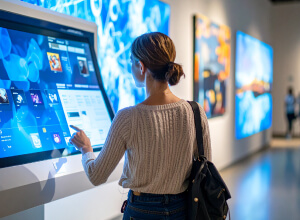Bringing Scotland’s Moving Image Archive to life through an interactive multi-touch experience.
Intuiface brings to life a vast collection of archive material for the National Library of Scotland with an interactive experience
Many archives, libraries and museums are now facing a similar challenge to the one that the National Library of Scotland faced when opening their Moving Image Archive to the public for the very first time.
Their challenge was how to make their vast collection of archive material easy to access and inviting for the public to explore. When it comes to public access, so much of this wealth is hidden away in vaults, strong rooms or stuck inside a catalogue, where it is inaccessible and often only targeted to a small academic audience.
Now that we live in a digital age, museums, libraries and archives are exploring new ways to bring this information to life and make it open and accessible for the public to enjoy.
Currently catalogues are a key source to accessing this information but they can be intimidating and complex to use. If the user isn’t experienced, then it’s not always clear how they can explore the material, putting the vast majority of people off in the process. This is a crying shame as these archives are central to our culture, growth and education.
For the National Library of Scotland, as is typical of so many institutions, the Moving Image Archive was held in an industrial estate with only specialist researchers accessing the content on a regular basis. In designing their new facility at the historic Kelvin Hall in Glasgow, they were determined that the centre would be accessible and available to everybody.

At the very heart of their new centre the National Library of Scotland decided to use touchscreen interfaces to allow the public to tap into and explore the huge collection of over 46,000 documentaries, creative, experimental and observational films spanning the last 100 years of Scotland’s history.
“We wanted to have a really interactive experience for visitors
coming in. We wanted it to be a communal experience as well, so that people
could sit next to each other and look, share and talk about our collections.”
The films were organised into curated themes so rather than the public being presented with a vast collection of films and information they could browse the collection based on themes, such as fashion, education and
shipbuilding etc.

With this curated strategy in mind, the touchscreens were not designed to replace the full catalogue available at Kelvin Hall but to very much work in tandem with it. The accessible nature of touchscreen technology ensured that the curated interface was an easy gateway to the catalogue.
“For me a space like this is hugely important. It's breaking down
barriers the archives and libraries have traditionally had, in their academic
sense, and it's opening them up to everyone."
This approach has far exceeded the expectations that the National Library of Scotland set out to achieve and the public have responded very positively. Now, users of all ages can access the Moving Image Archive through the curated interface, with pensioners able to share the material together, giggling away at something they remember, or sharing these memories with their great-grandchildren. School children are completely at ease with touchscreens and need no invitation to start playing with the material – something that they wouldn’t have done with a traditional catalogue.
Behind the scenes, the National Library of Scotland wanted to use Intuiface as the software platform to build the interface with. It allowed them to have the interactive functionality that they wanted, with the ability to process data directly from their well-established cataloguing database to give users the wealth of curated content they wanted.
The ease of IntuiFace’s intuitive WYSIWYG editor helped them quickly build prototypes before engaging with IntuiFace Gold Experts, to build the final touchscreen experience. The IntuiFace team were on hand and attentive throughout the development process for both the National Library of Scotland and POPcomms.
“I would absolutely recommend to other museums, galleries and
libraries to use a product like IntuiFace and it's a great way to build an
immersive interface that people can easily engage with.”
Looking forward, the National Library of Scotland want to continue to grow their audience, engaging with as many people as possible through this new experience. They want young people to look into the past; groups to discuss and laugh; and older generations to bring their knowledge of the collection to Kelvin Hall and share their stories.

The result of the Moving Image Archive and the curated touchscreen interface are wonderful to see. It’s clear that the curated interface prompts discussion, reminiscence and nostalgia, helping users start their journey into this fabulous collection, with the Moving Image Archive finally having a home celebrating the history of Scottish film.
“My passion is public engagement and I want to make sure that the
widest number of people get to access our content. What we've got in the
curated interface is something that really tells people that we want them here
and we want them to enjoy themselves because, after all, that's what our
collections are about; they're about fun and enjoyment.”





